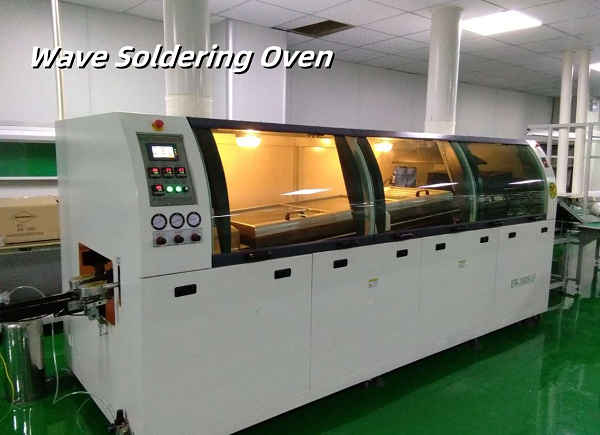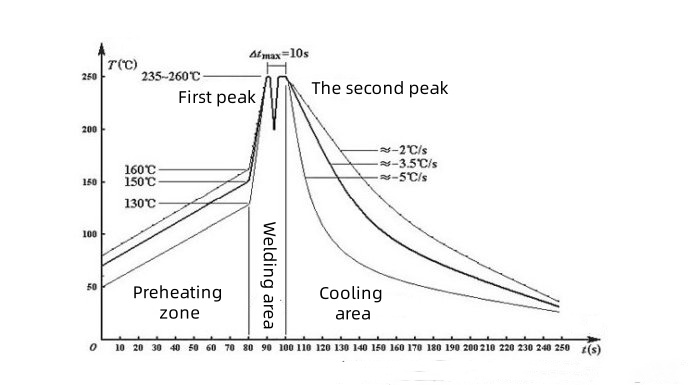
Wave soldering temperature profiles refer to the time and temperature curve of the printed circuit board when processed in the wave soldering machine.
This is an important parameter for the wave soldering procedure. It will have a direct impact on soldering efficiency and quality.
The Composition of Wave Soldering Temperature Graph
The temperature curve for wave soldering is generally composed of three parts:
Preheating Area: The preheating zone is used for heating the circuit board, components and to ensure the solvent elements in the flux are vaporized by heat. This will prevent explosions and tin particles problems.
Soldering Area: The solder is melted in this area, so it fills and wets the joint. This creates a solder connection that is fixed.
Cooling Zone: The zone is used for cooling and solidifying the solder, and preventing defects in solder joints.

Wave Soldering Temperature Curve: What Is It For?
Control of welding quality: The wave soldering temperature is an important basis for welding quality.
Soldering defects can be reduced by optimizing the temperature curve for wave soldering.
Increased production efficiency: Optimization of the wave soldering curve can reduce soldering times and increase production efficiency.
Cost Control: Optimizing wave soldering temperatures curves can reduce defects and scrap rates, and reduce costs.
Wave Soldering Temperature Curve Optimization
Optimize the temperature curve for wave soldering by considering the following factors:
Select the right temperature for the time:
The preheating temperatures are too low and the solvents in the flux won't be fully volatilized. This will result in bubbles or tin particles. The components will be damaged if the preheating temperatures is too high.
If the time for preheating is not long enough, the solvents in the flux are not completely volatilized. This results in bubbles and particles of tin. The circuit board will overheat if the preheating period is too long. This will affect the quality of the weld.
If the temperature of soldering is set too low, it will result in cold soldering. If the soldering temperatures is too high the solder will overexpand, leading to bridging or pores.
Cold soldering can occur if the time for soldering is not long enough. Soldering too long will cause the solder to expand excessively and result in pores, bridges, and bridging.
A temperature of cooling that is too low will result in a poor solidification, which results in cold soldering. A cooling temperature that is too high will result in excessive shrinkage and pores.
The solder will fail to solidify properly if the time of cooling is not long enough. This can result in cold solder joints. The solder will shrink too much if the cooling time is excessively long. This can result in pores.
Share a Parameter for Setting the Temperature of Wave Soldering
1. The temperature range for the peak is 255degC265degC
2. Preheating temperatures are 90degC to 120degC
3. Warm-up is between 80 and 150 seconds.
4. The heating slope is a 13degC/degC
5. Soldering Time: Flat wave + disturbance wave = 35 seconds
6. The slope of the cooling system varies depending on its cooling system, but is usually acceptable between 5-12degC/sec.
Optimize Your Website Using the Optimization Method
Methode expérimental: By experimenting, adjust the curve of the welding temperature to achieve the best possible welding effect.
Simulation Method: Use simulation to simulate welding effects using different temperature curves.
Data Analysis Method: Find the factors that affect welding quality by analyzing historical data and optimizing the welding temperature curve according to them.
Future Development of Wave Soldering Curve
Wave soldering temperatures curves have to be adjusted more frequently as electronic products continue to develop.
The wave soldering temperature will continue to develop in the same direction.
Intelligenter: We can optimize wave soldering temperatures automatically using artificial intelligence and machine-learning technologies.
More environmentally friendly: By using solder and flux that are more environmentally-friendly, you can reduce environmental impact.
Reduce welding energy consumption: by optimizing welding processes, can reduce welding energy consumption.
Conclusion
Wave soldering temperature is an important parameter for the wave soldering procedure. It can have a direct impact on soldering efficiency and quality.
Increasing the efficiency of production can be achieved by optimizing the temperature curve for wave soldering. This will improve soldering and reduce costs.









